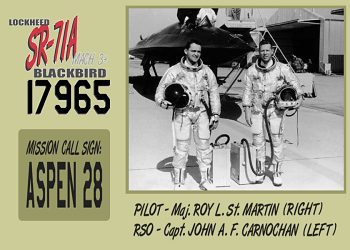 |
On 25 October 1967, Maj. Roy L. St. Martin and his Reconnaissance Systems Operator (RSO) Capt. John A. F. Carnochan of the 1st Strategic Reconnaissance Squadron took off for a three hour night training flight, using call sign ASPEN 28. They were scheduled to fly Papa Route, consisting of a high-altitude supersonic leg to BUSY PALACE air-refueling area near Albuquerque, New Mexico, followed by a second climbing acceleration east of Denver and return to Beale on a westbound leg north of Salt Lake City, Utah. The flight progressed normally through the air-refueling and second acceleration to supersonic cruise. Descent and deceleration from cruise was initiated in the vicinity of Elko, Nevada, approximately two hours and fifteen minutes after takeoff.
The pilot soon observed a warning flag on the bank steering bar of the attitude director indicator (ADI) and noticed that the autopilot had become disconnected. The ADI showed wings level flight and the horizontal situation indicator (HSI) showed straight, non-turning flight. Because of the warning flag on the ADI steering bar, the pilot switched the attitude reference source to the Flight Reference System (FRS). The ADI showed an immediate unusual attitude of undetermined magnitude, and both the warning flag on the steering bar and the OFF flag on the ADI appeared simultaneously.
The pilot advised the RSO that he had attitude indicator malfunctions and the RSO confirmed that his astro-inertial navigation system (ANS) had stopped functioning as a valid reference source. The RSO, on FRS, observed his attitude indicator reflecting a large left wing low, diving turn. Due to the radical attitude displayed in FRS, he stated to the pilot that the FRS was inoperative. The RSO switched to ANS and it showed wings level, constant heading. The crew was not aware that the aircraft was making a 180-degree turn toward the east. The pilot had no outside reference to assist him in recovering from the unusual attitude because of the darkness. Recovery could not be affected using the standby attitude indicator. The pilot directed the RSO to bailout at about 30,000 feet. The pilot remained with the aircraft briefly, continuing his efforts to recover, but was unsuccessful. He then ejected. Both crewmembers survived.
The aircraft struck the ground in the Trinity Range north of Lovelock, Nevada. It impacted in a near vertical dive and was totally destroyed. The aircraft had logged a total of 204.6 flight hours during its lifetime.
 |
